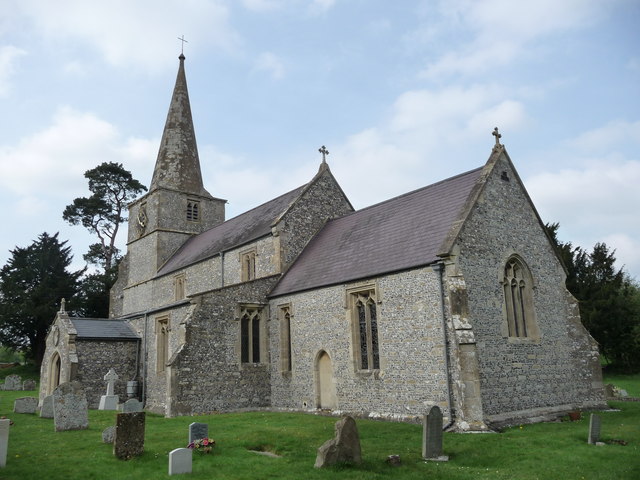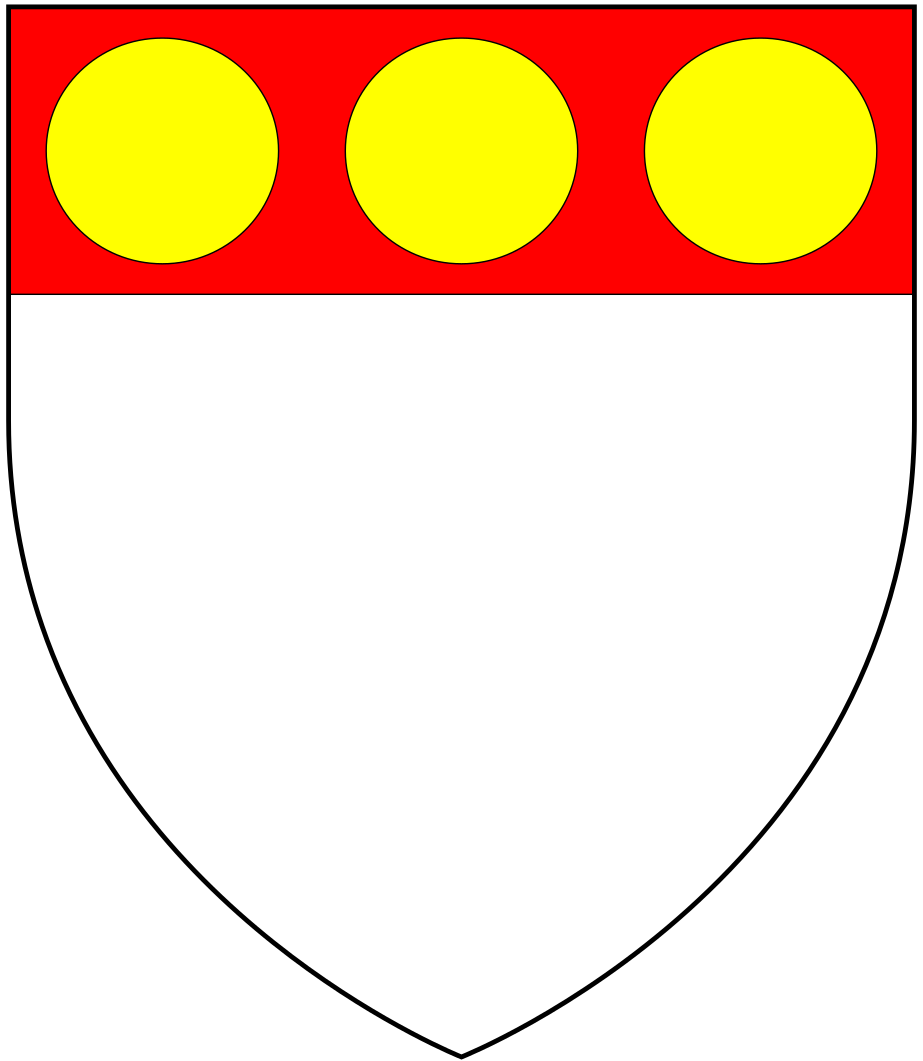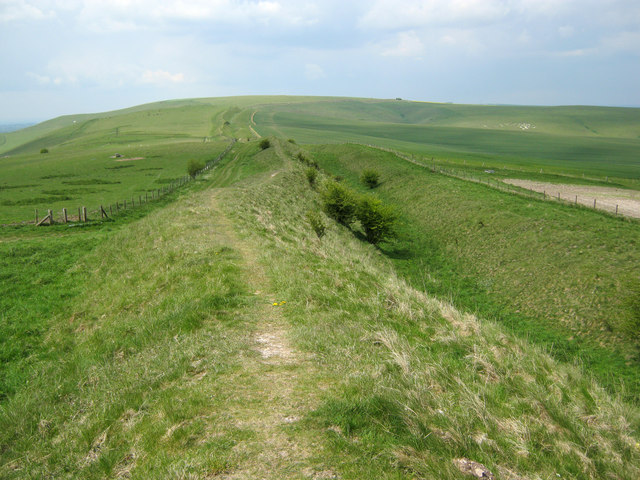|
Little Bedwyn
Little Bedwyn (also spelt Little Bedwin, and sometimes called Bedwyn Parva) is a village and civil parish on the River Dun in Wiltshire, England, about south-west of the market town of Hungerford in neighbouring Berkshire. The parish includes the hamlet of Chisbury. The Kennet and Avon Canal and the Reading to Taunton railway line follow the Dun and pass through the village. Little Bedwyn is served by Bedwyn railway station, which is about south-west of the village at Great Bedwyn. History About west of Little Bedwyn is Chisbury Camp, an Iron Age hillfort consisting of earthworks which enclose some . Within the camp is the former St Martin's chapel, a Decorated Gothic building of flint, now a farm building. Bedwyn Dyke, an early medieval fortification with similarities to the Wansdyke, stretches some 2.8 km southeast from the hillfort. Most of Little Bedwyn was part of a larger estate called Bedwyn, which in the early Middle Ages was held by the kings of Wessex ... [...More Info...] [...Related Items...] OR: [Wikipedia] [Google] [Baidu] |
Wiltshire Council
Wiltshire Council is a council for the unitary authority of Wiltshire (excluding the separate unitary authority of Swindon) in South West England, created in 2009. It is the successor authority to Wiltshire County Council (1889–2009) and the four district councils of Kennet, North Wiltshire, Salisbury, and West Wiltshire, all of which were created in 1974 and abolished in 2009. Establishment of the unitary authority The ceremonial county of Wiltshire consists of two unitary authority areas, Wiltshire and Swindon, administered respectively by Wiltshire Council and Swindon Borough Council. Before 2009, Wiltshire was administered as a non-metropolitan county by Wiltshire County Council, with four districts, Kennet, North Wiltshire, Salisbury, and West Wiltshire. Swindon, in the north of the county, had been a separate unitary authority since 1997, and on 5 December 2007 the Government announced that the rest of Wiltshire would move to unitary status. This was later put in ... [...More Info...] [...Related Items...] OR: [Wikipedia] [Google] [Baidu] |
Earthworks (archaeology)
In archaeology, earthworks are artificial changes in land level, typically made from piles of artificially placed or sculpted rocks and soil. Earthworks can themselves be archaeological features, or they can show features beneath the surface. Types Earthworks of interest to archaeologists include hill forts, henges, mounds, platform mounds, effigy mounds, enclosures, long barrows, tumuli, ridge and furrow, mottes, round barrows, and other tombs. * Hill forts, a type of fort made out of mostly earth and other natural materials including sand, straw, and water, were built as early as the late Stone Age and were built more frequently during the Bronze Age and Iron Age as a means of protection. See also Oppidum. * Henge earthworks are those that consist of a flat area of earth in a circular shape that are encircled by a ditch, or several circular ditches, with a bank on the outside of the ditch built with the earth from inside the ditch. They are believed to have been used as mo ... [...More Info...] [...Related Items...] OR: [Wikipedia] [Google] [Baidu] |
Great Bedwyn (UK Parliament Constituency)
Great Bedwyn was a parliamentary borough in Wiltshire, centred on Great Bedwyn, which elected two Members of Parliament (MPs) to the House of Commons from 1295 until 1832, when the borough was abolished by the Great Reform Act. Members of Parliament 1295–1640 1640–1832 Notes References *Robert Beatson''A Chronological Register of Both Houses of Parliament''(London: Longman, Hurst, Res & Orme, 1807) *D Brunton & D H Pennington, ''Members of the Long Parliament'' (London: George Allen & Unwin, 1954) *''Cobbett's Parliamentary history of England, from the Norman Conquest in 1066 to the year 1803'' (London: Thomas Hansard, 1808) viInternet Archive* J Holladay Philbin, ''Parliamentary Representation 1832 – England and Wales'' (New Haven: Yale University Press, 1965) *Henry Stooks Smith, ''The Parliaments of England from 1715 to 1847'' (2nd edition, edited by FWS Craig – Chichester: Parliamentary Reference Publications, 1973) * * {{Cite journal , last=Ward , first=J ... [...More Info...] [...Related Items...] OR: [Wikipedia] [Google] [Baidu] |
William Russell (knight)
Sir William Russell (1257–1311) was an English nobleman, knight, and holder of a ''moiety'' of the feudal barony of North Cadbury, Somerset, but spent most of his life engaged in the administration and defence of the Isle of Wight, where he obtained by marriage the manor of Yaverland. He served as constable of Carisbrooke Castle, and sat in parliament on two occasions, firstly as burgess for Great Bedwyn, Wiltshire, and then for the County of Southampton. As a baron his military service was called on several times by King Edward I ''Hammer of the Scots''. Origin William Russell was the third son and eventual heir of Sir Ralph Russell (b. 1204), son of Sir John Russell (d. c. 1224) of Kingston Russell, Dorset, steward of Kings John (1199–1216) and his young son Henry III (1216–1272). Shortly before his death King John had granted Russell the manor of Kingston by grand serjeanty, which grant was confirmed by Henry. William had inherited from his mother Isabel de Newma ... [...More Info...] [...Related Items...] OR: [Wikipedia] [Google] [Baidu] |
John, King Of England
John (24 December 1166 – 19 October 1216) was King of England from 1199 until his death in 1216. He lost the Duchy of Normandy and most of his other French lands to King Philip II of France, resulting in the collapse of the Angevin Empire and contributing to the subsequent growth in power of the French Capetian dynasty during the 13th century. The baronial revolt at the end of John's reign led to the sealing of , a document considered an early step in the evolution of the constitution of the United Kingdom. John was the youngest of the four surviving sons of King Henry II of England and Duchess Eleanor of Aquitaine. He was nicknamed John Lackland because he was not expected to inherit significant lands. He became Henry's favourite child following the failed revolt of 1173–1174 by his brothers Henry the Young King, Richard, and Geoffrey against the King. John was appointed Lord of Ireland in 1177 and given lands in England and on the continent. He unsuccessfully atte ... [...More Info...] [...Related Items...] OR: [Wikipedia] [Google] [Baidu] |
Kingston Russell House
Kingston Russell House is a large mansion house and manor near Long Bredy in Dorset, England, west of Dorchester. The present house dates from the late 17th century but in 1730 was clad in a white Georgian stone facade. The house was restored in 1913, and at the same time the gardens were laid out. Location The house is on land which was granted to the Russell family (previously thought not ancestors of the Russell Dukes of Bedford), by an early king, probably John, King of England (reigned 1199–1216) at the end of his reign, or his son Henry III of England. Kingston Russell manor is now part of Long Bredy parish, but earlier appears to have had its own church. The main part of the manor adjoins Winterbourne Abbas to the east and Compton Valence to the north, whilst the house itself adjoins Long Bredy. It is situated in an area known for ancient tumuli and the Kingston Russell Stone Circle. The Poor Lot barrow group forms a boundary with Littlebredy and Winterbourne ... [...More Info...] [...Related Items...] OR: [Wikipedia] [Google] [Baidu] |
John Russell (knight)
Sir John Russell (died c. 1224) of Kingston Russell in Dorset, England, was a household knight of King John (1199–1216), and of the young King Henry III (1216–1272), to whom he also acted as steward. He served in this capacity as custodian of the royal castles of Corfe (1221 and 1224) and Sherborne (1224) in Dorset and of the castles of Peveril and Bolsover in Derbyshire. He served as Sheriff of Somerset in 1223-1224. He was granted the royal manor of Kingston Russell in Dorset under a feudal land tenure of grand serjeanty. Between 1212 and about 1215 he acquired a moiety of the feudal barony of Newmarch, (shared with John de Bottrel/Bottreaux) the caput of which was at North Cadbury, Somerset, in respect of which he received a summons for the military service of one knight in 1218. Debt to Jews Russell had obtained a loan from Aaron the Jew of Lincoln (died 1186), the greatest of the Jewish financiers licensed to trade in England, and on the seizure of Jewish assets by ... [...More Info...] [...Related Items...] OR: [Wikipedia] [Google] [Baidu] |
List Of English Monarchs
This list of kings and reigning queens of the Kingdom of England begins with Alfred the Great, who initially ruled Kingdom of Wessex, Wessex, one of the heptarchy, seven Anglo-Saxon kingdoms which later made up modern England. Alfred styled himself King of the Anglo-Saxons from about 886, and while he was not the first king to claim to rule all of the English people, English, his rule represents the start of the first unbroken line of kings to rule the whole of England, the House of Wessex. Arguments are made for a few different kings thought to have controlled enough Anglo-Saxon kingdoms to be deemed the first king of England. For example, Offa of Mercia and Egbert of Wessex are sometimes described as kings of England by popular writers, but it is no longer the majority view of historians that their wide dominions are part of a process leading to a unified England. Historian Simon Keynes states, for example, that "Offa was driven by a lust for power, not a vision of English ... [...More Info...] [...Related Items...] OR: [Wikipedia] [Google] [Baidu] |
List Of Monarchs Of Wessex
This is a list of monarchs of Wessex until AD 886. For later monarchs, see the List of English monarchs. While the details of the later monarchs are confirmed by a number of sources, the earlier ones are in many cases obscure. The names are given in modern English form followed by the names and titles (as far as is known) in contemporary Old English (Anglo-Saxon) and Latin, the prevalent languages of record at the time in England. This was a period in which spellings varied widely, even within a document. A number of variations of the details below exist. Among these are the preference between the Rune, runic character ''Thorn (letter), thorn'' (Þ, lower-case þ, from the Thorn (rune), rune of the same name) and the letter ''eth'' (Ð or ð), both of which are equivalent to modern ⟨th⟩ and were interchangeable. They were used indiscriminately for Voice (phonetics), voiced and unvoiced /th/ sounds, unlike in modern Icelandic orthography, Icelandic. ''Thorn'' tended to be more ... [...More Info...] [...Related Items...] OR: [Wikipedia] [Google] [Baidu] |
Middle Ages
In the history of Europe, the Middle Ages or medieval period lasted approximately from the late 5th to the late 15th centuries, similar to the post-classical period of global history. It began with the fall of the Western Roman Empire and transitioned into the Renaissance and the Age of Discovery. The Middle Ages is the middle period of the three traditional divisions of Western history: classical antiquity, the medieval period, and the modern period. The medieval period is itself subdivided into the Early, High, and Late Middle Ages. Population decline, counterurbanisation, the collapse of centralized authority, invasions, and mass migrations of tribes, which had begun in late antiquity, continued into the Early Middle Ages. The large-scale movements of the Migration Period, including various Germanic peoples, formed new kingdoms in what remained of the Western Roman Empire. In the 7th century, North Africa and the Middle East—most recently part of the Eastern Ro ... [...More Info...] [...Related Items...] OR: [Wikipedia] [Google] [Baidu] |
Wansdyke (earthwork)
Wansdyke (from ''Woden's Dyke'') is a series of early medieval defensive linear earthworks in the West Country of England, consisting of a ditch and a running embankment from the ditch spoil, with the ditching facing north. There are two main parts: an eastern dyke which runs between Savernake Forest, West Woods and Morgan's Hill in Wiltshire, and a western dyke which runs from Monkton Combe to the ancient hill fort of Maes Knoll in historic Somerset. Between these two dykes there is a middle section formed by the remains of the London to Bath Roman road. There is also some evidence in charters that it extended west from Maes Knoll to the coast of the Severn Estuary but this is uncertain. It may possibly define a post-Roman boundary. Usage Wansdyke consists of two sections, long with some gaps in between. East Wansdyke is an impressive linear earthwork, consisting of a ditch and bank running approximately east–west, between Savernake Forest and Morgan's Hill. West Wansd ... [...More Info...] [...Related Items...] OR: [Wikipedia] [Google] [Baidu] |
Flint
Flint, occasionally flintstone, is a sedimentary cryptocrystalline form of the mineral quartz, categorized as the variety of chert that occurs in chalk or marly limestone. Flint was widely used historically to make stone tools and start fires. It occurs chiefly as nodules and masses in sedimentary rocks, such as chalks and limestones.''The Flints from Portsdown Hill'' Inside the nodule, flint is usually dark grey, black, green, white or brown in colour, and often has a glassy or waxy appearance. A thin layer on the outside of the nodules is usually different in colour, typically white and rough in texture. The nodules can often be found along s and |






